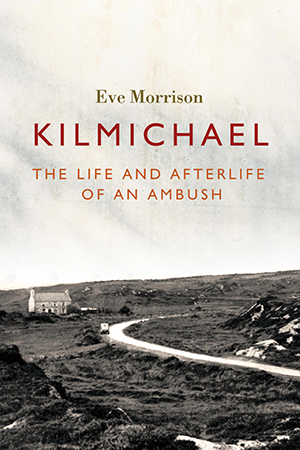KILMICHAEL: THE LIFE AND AFTERLIFE OF AN AMBUSH
Published in Book Reviews, Book Reviews, Issue 3 (May/June 2022), Reviews, Volume 30 EVE MORRISON
EVE MORRISON
Irish Academic Press
€19.95
ISBN 9781788551458
Reviewed by Gerry White
Gerry White is a former member of the Defence Forces and the author of The burning of Cork (Mercier Press, 2006).
On 28 November 1920, an IRA flying column led by Tom Barry ambushed a mobile patrol of Auxiliaries near Kilmichael in West Cork. Seventeen Auxiliaries and three members of the column lost their lives in what proved to be one of the most sensational and bloody incidents of the War of Independence. It was also one of the most controversial. The controversy has focused on whether the column’s fatalities were the result of a ‘false surrender’ by some Auxiliaries, who were subsequently killed by the IRA, or whether some Auxiliaries were eliminated after a genuine surrender.
The most popular and widely accepted account of the false surrender appeared in Tom Barry’s Guerrilla days in Ireland, published in 1949. Barry’s account remained largely unchallenged until 1973, when Liam Deasy, the IRA adjutant of Cork No. 3 Brigade, published Towards Ireland free, a history of the IRA campaign in West Cork, which omitted the false surrender. This was sharply rebuked in a booklet published by Barry. It also led to divisions among surviving members of the column. The debate eventually died down but it exploded following the publication in 1998 of The IRA and its enemies: violence and community in Cork, 1916–1923 by Canadian historian Peter Hart, which dismissed the false surrender and claimed that Barry’s account was ‘riddled with lies and evasions’. The book unleashed a war of words between Hart and his supporters and critics. Now the latest chapter of the story has arrived with the long-awaited publication of this book by Eve Morrison.
Morrison has spent a number of years identifying and consulting a wide variety of sources about Kilmichael. Some, like the taped interviews of members of the column conducted by Fr John Chisholm, will be new to many readers. She also spoke to a number of people who have had an interest in the ambush. Notable exceptions are the papers of Tom Barry himself, to which Morrison claims she was denied access, and the insights of Barry’s biographer, Meda Ryan, and the historian Dr Brian P. Murphy OSB, both of whom she said declined to be interviewed. Her sources are listed in 58 pages of endnotes and an extensive bibliography. The book also includes a number of maps, photographs and five different accounts of the ambush, which appear in the appendices.
As its title indicates, the book has two themes. Seven chapters are devoted to different aspects of the ambush, including its historical context, immediate press coverage and political impact. Details of the participants and the revolutionary careers of Tom Barry and Liam Deasy are examined, as are the historical accounts, memoirs, social memory and folklore relating to Kilmichael. She also provides her own detailed reconstruction of the ambush.
As column commander, the part played by Tom Barry looms large. Morrison describes him as ‘fiery, charismatic and exceptionally brave’, qualities that can be beneficial to a wartime military commander. She also says, however, that he was ‘unpredictable and as changeable as the weather’ and someone who could ‘provoke equal measures of hostility, admiration and allegiance’. She subjects Barry’s published accounts of the ambush to close scrutiny and devotes an entire chapter to his relationship and dispute with Liam Deasy.
Morrison admits that it is impossible to know exactly what happened at Kilmichael, but for her reconstruction she utilised all the available sources, including maps, contemporary press photographs, a modern aerial photograph of the site, and the private and confidential accounts of ambush veterans. Her account vividly illustrates the chaos, confusion and ferocity that defined the combat and the impact it had on members of the column. The issue of the false surrender also gets considerable attention. With regard to accounts of the ambush published by Barry, IRA veteran Stephen O’Neill, Liam Deasy and the West Cork historian Flor Begley, Morrison concludes that Barry’s is the ‘least supported by other veterans’ testimony’.
The final two chapters cover revisionism and anti-revisionism, the impact that the Northern Ireland conflict had on the historiography, public history and commemoration of Kilmichael, and the controversy that erupted following the publication of Peter Hart’s book. While Morrison identifies a number of errors that Hart made, she believes that they have been blown out of proportion. Taking aim at his critics, she says that their conclusions are at odds with most of the evidence relating to Kilmichael and that their arguments become ‘more convoluted, speculative and hypocritical with every passing year’. She also provides evidence to refute one of the main allegations made against Hart—that he claimed to have interviewed Ned Young, a veteran of the ambush, several days after Young died. She concludes by describing the ‘conspiratorial turn’ of the Kilmichael debate as a ‘cautionary tale’ and makes a call for the return of ‘reasoned inquiry and honest disputation’.
Eve Morrison’s book is both informative and thought-provoking and there is plenty of material within its covers for readers to consider. For anyone interested in the Kilmichael ambush, its historiography and that of the War of Independence, it’s a ‘must read’. While some will agree with its contents, I’m sure others will disagree and more may have their own long-held perceptions of the ambush challenged. One thing is certain, though: its publication will add yet more life to the already long ‘afterlife’ of the Kilmichael ambush.
















